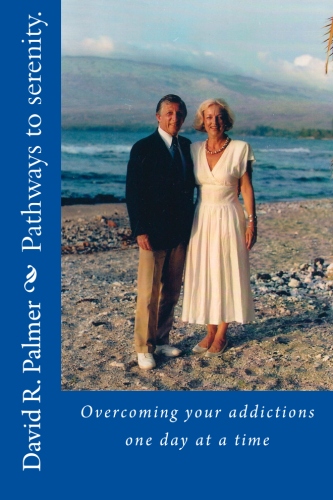By David Palmer
 I’ve known Bobby Ward for most of his 20 years of sobriety and have been entertained and enlightened at recovery meetings over the years by his story, which he delivers with self-deprecating humor illuminated by a megawatt smile.
I’ve known Bobby Ward for most of his 20 years of sobriety and have been entertained and enlightened at recovery meetings over the years by his story, which he delivers with self-deprecating humor illuminated by a megawatt smile.
So it was with great anticipation that I drove over to the UAMS Psychiatric Hospital to pay him a visit. Bobby, who has since left the hospital for another job, was a clinical director for substance abuse treatment and directed the chemical dependence outpatient programs for both marijuana and opiate prescription drug addictions. He knows his stuff.
Bobby, now happily married with three kids brings to his position plenty of “street cred” and savvy from working at two treatment centers before joining UAMS. It is an interesting background compared to that of the hospital’s largely academic staff whose members are working on a variety of groundbreaking research projects and studies.
Bobby is not an academic type, but he has all the qualifying credentials he needs hanging on the walls of his sunny office. Still, much of his education in the treatment of addictions comes from the streets.
Bobby, like many in recovery, has been profoundly influenced by the late Joe McQuany, author of the Recovery Dynamics treatment curriculum, founder of Little Rock’s Serenity Park treatment facility and an internationally known speaker on alcoholism and recovery.
He credits McQuany with his belief that alcoholism is a disease affecting the body, mind and spirit. All of them, he says, must be addressed before recovery can take place. To make his point, Bobby parses the word “disease” as McQuany did, which simply means “away from ease.”
Ward also began to study the Big Book of Alcoholics Anonymous which, he says, gives him wisdom and spiritual focus, and in talking about recovery he refers to it and quotes from it regularly.
Basically, Ward got well by working the 12 Steps and by learning how to apply them from McQuany while sitting under the crabapple tree at Serenity Park and at Monday night meetings at the Wolfe Street Center.
Ward understands the terms that psychologists use to describe addiction and treatment like “matrix model” and ”cognitive therapy” and in fact does most of what they describe, but it is not a language addicts use, and he smiles at its academic flavor.
For example, the National Institute on Drug Abuse (NIDA) says “the goal of the matrix model has been to provide a framework within which stimulant abusers can achieve the following: (a) cease drug use (b) stay in treatment (c) learn about issues critical to addiction and relapse (d) receive direction and support from a trained therapist (e) receive education for family members affected by the addiction (f) become familiar with self help programs, and (g) receive monitoring by urine testing.
The model also requires that therapists use a combination of skills required “to function simultaneously as teacher and coach…to promote self esteem, dignity and self worth.’”
Flashing his ready smile, Bobby says this is basically what he does, but he might use different words to describe it based on his own experience as an addict with a 12-step background. And he would probably say that ultimately you get self-esteem from doing estimable things.
Cognitive therapy, according to the Academy of Cognitive Therapy. involves three primary activities, “education, skill building and problem solving. During treatment, the client actively applies strategies learned to the problems which brought him to therapy. If indicated, Cognitive Therapy is also compatible with the use of prescribed medication [i.e. suboxen and methadone].
Over the years Bobby has developed strong opinions about addiction and recovery. He favors the use of suboxone and methadone to treat opiate and heroin addictions. He condemns the notion that marijuana addiction is relatively harmless. He believes that methamphetamine is perhaps the most evil drug and needs more attention. Finally, he believes that stopping the supply of drugs on the Mexican border can only become truly effective when we dry up the demand for drugs this side of the border.
Bobby started the outpatient suboxone program at UAMS, which is used as previously noted for treating patients who are addicted to opiate prescription drugs such as oxycontin, percocet, hydrocodone, vicodin, codeine, morphine, lortab, darvocet and other pain medications.
Suboxone, which is less addictive than opiates, is given to patients over a period of time in ever decreasing doses so that they can continue to function without the severe withdrawal symptoms associated with opiates while they are learning the principals and strategies of recovery.
UAMS also has a methadone clinic which serves those who are addicted primarily to heroin on the same principal. Heroin addicts are given methadone in closely monitored doses which they pick up daily at the clinic.
There are those in the addiction field who disagree with UAMS and Bobby on the use of drugs, which are themselves addictive, to treat drug abuse, but he defends it.
With suboxen, he says, the addict can begin to “start stopping” in his program of recovery, and as proof of the efficacy of the program, Bobby claims a 90 percent success rate for prescription drug addicts.
For those who think that marijuana is a mild and relatively benign drug, Bobby, who oversees the marijuana clinic, begs to differ.
“Weed and alcohol are the worst drugs of all because they destroy brain cells,” Bobby says. “And it takes one to five years to get marijuana and alcohol out of your system.’
To those who suggest that marijuana doesn’t really impair driving, Bobby says, “marijuana is why they changed the Driving While Intoxicated (DWI) charge to Driving Under the Influence (DUI) to cover weed and other drugs.”
Meth, according to Bobby, is an underestimated evil which flourishes in the state’s vast rural areas where meth cookers replaced the moonshiners of bygone days.
“Like moonshine once was, Arkansas is the capitol of meth,” Bobby says, pointing out that authorities shy away from shutting down the meth labs because the toxic materials used require authorities to treat labs as hazardous waste sites at a cost to the state of $340,000 per site.
“It’s much less costly to go after the crack houses,” Bobby says.
So what about the drug wars?
He shares with many the belief that we should spend more time drying up the demand for drugs, which he says is increasing. It makes sense financially, Bobby says.
“The average cost of substance abuse treatment,” he says, “is about $1,583, resulting in monetary benefits of $11,487 through reduced medical expenses, reduced cost of crime and increased earnings.”
Bobby has a good life now. Recalling the days when he was abusing alcohol and other drugs, he says, “My alcoholic life took me on a journey I wouldn’t wish on my worst enemy. I spent time in many jails, caused many broken relationships, and I even sold my sister’s home.
”I got sober only by the grace of God on October 13, 1990 and for that I am truly grateful. I sobered up in the Salvation Army because I was broke and couldn’t afford treatment.
”Since that time, I have made amends to family members and others, and with my help and encouragement one of my sisters got sober after years of abusing alcohol.
”I have been employed ever since sobriety, and I have a wonderful wife, Sybil, and three beautiful boys who are all working and enrolled in college. Today, I have some really good friends, and I am totally committed to this program of recovery and helping others as ‘old timers’ helped me.
“I ended up working for a wonderful man, Joe McQuany, truly a gift from God, and I have been studying the AA Big Book ever since. Today, I enjoy the privilege of training counselors and serving on their certification board.”
Bobby has a special concern for prison inmates. “I truly believe if we could more effectively treat inmates for the alcohol and related problems we would significantly reduce recidivism, save money and create a whole new generation of productive citizens.”
Editor’s note: Bobby Ward, LADAC, CCS, AADAC, INADAC has worked in the recovery field for over 20 years. Prior to joining UAMS, he was the Director of Clinic Supervision at Serenity Park Treatment Center, and before that he worked for Hoover Treatment Center and was instrumental in the Center becoming the first accredited faith-based facility in Arkansas. Bobby has also worked extensively with persons infected with HIV/AIDS in their recovery from addictions.



